(reaching it, they're frogs and the similarity ends there. their attire is different, not to mention cid has a giant mustache) |
|||
| Line 202: | Line 202: | ||
===''Vagrant Story''=== |
===''Vagrant Story''=== |
||
*The barkeep, and later mini-theater owner, in Alexandria shares the same name and hair style of [[Ashley Riot]], ''[[Vagrant Story]]''<nowiki>'</nowiki>s protagonist. |
*The barkeep, and later mini-theater owner, in Alexandria shares the same name and hair style of [[Ashley Riot]], ''[[Vagrant Story]]''<nowiki>'</nowiki>s protagonist. |
||
| − | |||
| − | ===''Chrono Trigger''=== |
||
| − | *When Cid Fabool IX is transformed from an [[oglop]] into a frog on Disc 3 of ''Final Fantasy IX'', his frog form greatly resembles the character [http://chrono.wikia.com/wiki/Frog Frog] from ''[[Wikipedia:Chrono Trigger|Chrono Trigger]]''. |
||
===''Chrono Cross''=== |
===''Chrono Cross''=== |
||
Revision as of 21:15, 21 May 2011
I remember a guy with spiky hair who carried something like this.
Zidane Tribal after seeing a "Buster Sword"-like object in an equipment shop.
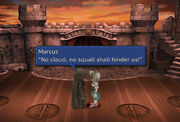
Zidane references Cloud and Squall.
Final Fantasy IX was intended, in many ways, to be a salute to the history of the series, and as such, it is filled with allusions and references to previous games. One of the most apparent is the similarity of the playable characters to the classic job classes of previous games, most notably Vivi to the Black Mage of the original Final Fantasy.
Unfortunately, despite the high quality of the translation overall, care was not taken to ensure that all of the various names and references matched up to those used in the previous English-language releases. Because of this, many of the references with which the game abounds are completely missed by the non-Japanese audience. Some examples are included below. This is a list of these allusions organized by game.
Final Fantasy Series
- An allusion to all three titles on the NES, several of the major cities include Chapels, which were the foremost method of saving, reviving felled party members, and healing one's HP and MP.
- Alexandria's chapel is near the western dock, where moogles Kupo, Stiltzkin, and Artemicion make appearances throughout the course of the game.
- The chapel in Lindblum is located in the Business District and is currently undergoing maintenance.
- Additionally, other locations such as Gizamaluke's Grotto, Esto Gaza, Conde Petie, and the Cleyra Settlement seem to be religious centers. None house chaplains offering services of game-saving or character revival, but coincidentally the empty chapel in Alexandria holds the first location in the game where one can use a Moogle to save one's game, use a Tent, or begin the Mognet sidequest.
- Furthermore, scattered across all of Gaia are pools where the party can replenish their HP and MP at no expense, often occurring as natural or volcanic springs, but none reside within the aforementioned chapels.
- It is often overlooked, perhaps due to the translation into English, but it is worth mentioning that each member of the Knights of Pluto (Steiner included) shares similar character traits or motivational aspirations to those of the main protagonists (or at least "lead male") of each game in the series prior to Final Fantasy IX respective to their rank number.
- Captain Adelbert Steiner - Devout knight and protector of the throne, sworn in blood to apprehend the thieves of the kidnapped princess (named "Sarah") to eventually thwart the evil-doings of a sinister man named "Garland". He parallels the Warrior of Light from the original title having chosen the Fighter class (swords and heavy armor as primary weaponry) and become a full-fledged Knight. Whether Bahamut played a role in that remains a mystery.
- Blutzen, Pluto Knight II - First to hear all the latest rumors, a super sleuth by trade, and a proud member of the Pluto Knights; when Alexandria is destroyed, he is at a loss for words on where to begin rebuilding. Blutzen very loosely reflects the actions of Firion (likely due to translation issues, Final Fantasy II having not received an official English translation at the time of Final Fantasy IX's North American release). The fact that Blutzen is the first to recognize castle rumors may reference the use of "keywords" in Final Fantasy II to glean information and rumors from NPCs. And Blutzen's lack of words upon the daunting reconstruction of Alexandria may mirror Firion's own grave situation, regarding the death of both his parents and how towering a task it will now be to rebuild his life and take on the Emperor. The fact that Firion is an allusion himself (to Luke Skywalker) doesn't make his connection to Blutzen any clearer.
- Kohel, Pluto Knight III - Often found with Blutzen, whom he likes to discuss the latest rumors; commonly gives generic, unrevealing responses to any question asked of him. Since the Luneth of Final Fantasy III did not exist until the 2006 DS iteration, Kohel more closely resembles the anonymous lead character portrayed in the game's original version. Kohel's heart is kind and he seeks to help the side of good, though he can tend to state the obvious.
- Laudo, Pluto Knight IV - No longer wishes to be a knight for his kingdom, asks his superior if he can quit the Knights of Pluto entirely in the castle library so he may pursue a career in writing fantasy novels; runs off crying when his superior says he can't. This parallels Cecil Harvey's desire to disband the Red Wings and leave behind him the ideals of the Dark Knight.
- Dojebon, Pluto Knight V - Seen as the first to respond to the crisis, frantically runs about the castle searching for the princess. Breireicht calls him a "famous artillerist". In Disc 2, he is seen in the Knights' Locker Room changing his clothing. This resembles Bartz Klauser to some extent, as he is closely attached to life-long friend Boco, his high-speed chocobo travel companion, and never stays in one place for too long on his journey; also the series title to which he is affiliated featured the return of the Job System, which required Bartz and company to equip an array of various weapons as they cycled through mastering the countless job classes at their disposal, which explains handily the title given to Dojebon by Breireicht and why he is "changing" clothes.
- Breireicht, Pluto Knight VI - The first words out of his mouth are that he's very tired because he's an older man; seen climbing up the tall west castle tower; recalls all of his comrades, then gives Steiner an Elixir for his troubles. Once Alexandria is destroyed, he wishes to rebuild the tower so that he can climb it once again. Breireicht is likely a representation of either Edgar Roni Figaro, Sabin Rene Figaro, or Cyan Garamonde due to his given age, though it is unclear since they all made the climb up Kefka's Tower at the sixth title's climax, and special care was given not to centralize one specific lead protagonist in Final Fantasy VI; also, a running gag in Final Fantasy VI was that Elixirs could be found in almost every grandfather clock the player encountered, later addressed when one could examine the only grandfather clock in Final Fantasy IX (in Quan's Dwelling) only to have a message stating it holds nothing.
- Weimar, Pluto Knight VII - Apparently gets together with a woman named "Barbara" at a "pub", according to Blutzen; he's then immediately observed hitting on a female comrade (Alexandrian soldier), and later flirts with a "flower girl" who proclaims he's, "...not exactly Mr. Personality," (they happen to be standing outside the dilapidated chapel in the destroyed Alexandria); responds stoically to his superior's command, as any good soldier does. This resembles the well-advertised love triangle present between Cloud Strife, Tifa Lockhart (Barbara, compared to 7th Heaven), and Aerith Gainsborough from Final Fantasy VII, though Cloud never openly womanizes in the manner Weimar does. The Alexandrian soldier Weimar flirts with likely alludes to the opportunity Cloud is given during the bombing mission at the game's beginning to flirt with fellow AVALANCHE member Jessie. His blunt response to Steiner's direct command reflects on Cloud's (believed) past as a member of SOLDIER, and he may even revere Steiner's superior abilities with the blade in a contrived sort of "Sephiroth!! Hero of the people!!" manner.
- Haagen, Pluto Knight VIII - Seen sitting alone at the docks, says the water brings peace to his soul, and asks his superior to join him; rises to immediate action once he discovers the princess is in danger, proclaiming he is personally on her trail, later divulging he would give his life for her. He mirrors Squall Leonhart, the consummate loner who denies the need to rely on others but was born a leader and loves a good fight. Haagen's reaction stems from the "Sorceress' Knight" complex that Seifer instils in Squall which he reflects on his need to protect Rinoa - the strongest theme in Final Fantasy VIII being that of the love between these two characters, as shown in the game's Amano logo design.
- Mullenkedheim, Pluto Knight IX - An oddball, and an enigma of sorts, only capable of commenting on how hungry he is in absolutely every instance throughout the game and nothing else. Though one might suspect Mullenkedheim to take after Zidane, he doesn't display any of his character traits (conniving thief, womanizer, trickster, resolute companion). Being that all of the other Pluto Knights reflect the character designs of lead male protagonists throughout the other games in the series, this behavior can only be explained as some sort of joke by the development team to imply that Quina Quen should be regarded as Final Fantasy IX 's main protagonist, as all s/he ever deflects to in his/her conversations is where and when Zidane can find the traveling party its next meal.
Final Fantasy
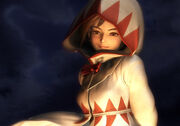
Garnet dressed as a White Mage.
- Garland shares his name with a character from the original game. The character Mikoto even goes so far as to mention later that, "Garland once tried to take control of the cycle of souls by force, but failed," the strongest evidence suggesting that perhaps the world of Final Fantasy IX is in direct relation to the events of the first game in the series.
- Mount Gulug was meant to be Gurgu Volcano, as seen in the original Final Fantasy, having a similar layout and dungeon music. The name is written in Japanese as グルグ, or "Gurugu". Interestingly, Mount Gulug in Final Fantasy IX was not originally from the planet of Gaia, but ended up warping there due to Garland's failed Fusion attempt to merge Gaia with another planet.
- Princess Cornelia, a character in the I Want to be Your Canary play, is also named after a location in the original title.
- Indeed, the entire World Map of Final Fantasy IX, Gaia itself, seems to be a tribute to the original game's topographic structure. All of the major landmasses are arranged in a manner that is extremely similar to Final Fantasy, though nations and locales (save for the aforementioned exceptions) vary considerably.
- The Pumice item in Final Fantasy IX, used to summon Ark, the massive, transforming airship, is known as "Fuyuuishi" (ふゆう石, or "floating stone"). In the original NES version of Final Fantasy, this item was translated as "FLOATER," and was used to lift the ancient airship from the desert. This bond is strengthened by the fact that Ark takes the form of a kind of airship.
- At the beginning of the game, during her escape, Princess Garnet's robe bears a strong likeness to the original White Mage.
- The four elemental fiends that protect the elemental shrines and are later fought in Memoria, are named Maliris, Tiamat, Kraken, and Lich, recalling their counterparts in the Final Fantasy. (In the anglicized version of Final Fantasy, the fiend of fire was called "Kary," although the name "Marilith" was restored in the Final Fantasy Origins version.)
- Crystals are a recurring motif beginning with the original Final Fantasy.
- When finding the potions to cure Cid, the items refer to the book of Matoya.
- Jane is a reference to Queen Jayne, who was called Queen Jane in some translations. Queen Jayne's daughter is Princess Sarah, and Jane's daughter is Garnet, whose real name is Sarah, who became a princess after fleeing Madain Sari.
- Alexandria Castle bears a resemblance to Castle Cornelia in Final Fantasy.
- The Ice Cavern is possibly a reference to the Ice Cavern from the original Final Fantasy.
- After escaping the Evil Forest at the beginning of the game, the party takes control of Zidane, Garnet, Vivi, and Steiner, which references the default party setup of the original Final Fantasy, in this case, Warrior (Steiner), Thief (Zidane), Black Mage (Vivi) and White Mage (Garnet).
- The layout of the beds in the inn at Dali is done in the same style as the beds in Final Fantasy I-III.
Final Fantasy II
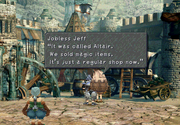
Altair mentioned at South Gate.
- During the first interlude in South Gate, the shop near the cable car is named Altair, which shares its name with the town the Wild Rose Rebellion fled to at the start of Final Fantasy II.
- More realistically, the name "Altair" was implemented to juxtapose the item shop in the northern station of South Gate named "Vega", which is a reference to the Tanabata legend in Japanese folklore. The stars Orihime (Vega) and Hikoboshi (Altair) are lovers separated by a river of stars (Milky Way). They are forced to meet only once a year on the seventh day of the seventh month. In Final Fantasy IX, the Aerbs Mountains seem to obstruct them and their lovesick owners. In fact, this relationship is the subject of the Mognet letter Grimo asks to deliver to Nanza.
- The giant boss creature, Hilgigars, was actually meant to be Hill Gigas. Gigas is a common name in the series for oversized humanoids, most frequently seen in Final Fantasy and Final Fantasy VII, and seen again as an entire beastmen race in Final Fantasy XI and later in Final Fantasy XII.
- In Gizamaluke's Grotto, the bells required to open the doors hearken back to the Goddess's Bell from Final Fantasy II which is used to open Kashuan Keep.
- Pandemonium was also the name of Emperor Mateus' castle of Hell. Additionally the music that accompanies the Pandemonium of Final Fantasy IX is simply a remix of its Final Fantasy II counterpart with a slower tempo.
- During the player's encounter with Ramuh, they are required to recite a story to earn his trust. The story actually describes an incident in Final Fantasy II involving an ice cave and a boulder which prompts one of the characters named Josef to sacrifice himself to save the others.
- Cid's wife, Hilda, shares her name with the leader of the Fynn Resistance in Final Fantasy II.
- In Lindblum, there is a man named Guy.
Final Fantasy III
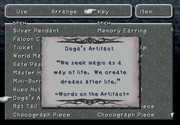
Doga's Artifact.
- "Une's Mirror" and "Doga's Artifact" can both be bought at the auction house.
- After the world of Terra has been destroyed, at the beginning of disc four and onwards, the player can return to Black Mage Village and examine the gramophone in the inn. If the player possesses the Doga's Artifact and Une's Mirror, the background music will change to a melody taken from the Final Fantasy III soundtrack; "Doga and Une's Theme". This melody continues on until the player leaves the village.
- Garland and Kuja's airship of destruction, Invincible, is named after the ultimate airship of Final Fantasy III.
- There also seems to be a thematic parallelism between Kuja/Xande and Necron/the Cloud of Darkness. Both fearing their mortality, Xande and Kuja unintentionally perform globally-perilous actions that lead both Necron and Cloud of Darkness to enter into the mortal realm and decide to revert the world to nothingness. Also, both Necron and Cloud of Darkness did not show up until the ending story as well as appearing as a final boss. The final boss music accompanying these encounters is also structurally similar.
Final Fantasy IV
- The dwarfs of Conde Petie use the same greeting as the dwarfs of Final Fantasy IV (ラリホ, or "rariho"). However, the original saying "Lali-ho" was changed to "Rally-ho" in Final Fantasy IX. It can be explained, since "R" in Japanese sounds like a cross between "L" & "R" in English and mistranslations are common throughout the series (such as Kiros' weapons in Final Fantasy VIII being labeled "katals"). Further localization to rationalize this translation choice took place by giving the dwarfs heavy Scottish accents, very strongly reminiscent of 18th Century Scottish poet Robert Burns.

Namingway's Tetra Master card
- Namingway appears as a Tetra Master card. The card allows the player to change the characters' names by showing it to a man in Daguerreo, similar to how Namingway allowed the player to rename characters in the original Final Fantasy IV.
- Cid's last name is "Fabool", which is a homophone for the kingdom of Fabul in Final Fantasy IV.
- Upon arriving in Lindblum for the first time, if the player searches the area that Steiner was just in during the ATE as he leaves the Inn, they will find a sign towards the Northwest part of the area called Polom's Action Figures; this a combination of the names of Palom and Porom, the twin mages of Final Fantasy IV.
- One of Freya's ultimate weapons is Kain's Lance, which is a reference to Final Fantasy IV 's dragoon, Kain Highwind.
- Zorn and Thorn have the ability to use Twincast, the ability of Palom and Porom. During the battle against them, they give each other the power to cast Flare and Meteorite (Comet).
- The Hilda Garde 1 strangely resembles the Lunar Whale of Final Fantasy IV.
- Garland's role is very similar to Fusoya's: they both watch over sleeping souls of an alien race and are related to the main hero of their respective games. In a cruel twist of fate Cecil was brought up as the King's adoptive son, whereas Zidane grew up as a Thief under Baku and Tantalus, but ultimately both became Kings. However, the biggest difference between Garland and Fusoya is that their alliances oppose one another.
- Zidane and Kuja, who are both brothers and come from a different world, somewhat mirrors Cecil and Golbez's relationship.

The Two Moons Card
- In Final Fantasy IV there are two moons, one of which is red. This is similar to the blue world of Gaia and the red one which is Terra. Similarly, in particular cutscenes both a red and blue moon are displayed in the skies of Gaia. The Ultimania guide references these as the Gaia and Terra Moons, whose orbital paths cross every 16 days when one becomes closer to the planet Gaia than the other. Gaia Moon is also slightly larger, as displayed in the Tetra Master card "Two Moons" which it references.
- Alexandria's army is comprised of only females, bar the Knights of Pluto. This is also true with Troia in Final Fantasy IV, a city the player visits during the course of the game.
- The destruction of the summoner tribe of Madain Sari is similar to the destruction of the summoner tribe from Mist.
- Vivi using his fire spell to melt ice in an early dungeon recall Rydia having to do the same for Cecil early in Final Fantasy IV
- Cleyra is called "City of Illusions". The title of the song music that plays in the Feymarch in Final Fantasy IV is called "City of Illusions".
- General Beatrix leads an assault of the Cleyra Settlement in order to steal the town's sacred jewel. Afterwards she wonders why such excessive force was necessary, and begins to question the Queen's motives. This mirrors Cecil's actions during the opening of Final Fantasy IV.
- The music playing in the Black Mage Village bears some similarities to the music playing in Final Fantasy IV's Mysidia.
Final Fantasy V

Boko's Tetra Master card

A card resembling Final Fantasy V's airship
- Though the melody differs significantly, the "Eternal Harvest" theme played during a cutscene in Cleyra bears a resemblance to the song "Harvest" from Final Fantasy V.
- Much of the melody heard in "Kuja's Theme" is heard in the Final Fantasy V song "Slumber of Ancient Earth".
- Upon Cornelia's death scene in the I Want to be Your Canary sequence, the player's death theme from Final Fantasy V is heard combined into the play's music.
- The Moogle theme from Final Fantasy V was remixed for the background music at Mognet Central.
- Boko has a Tetra Master card, and the images greatly resembles his original sprite. Furthermore, two Black Mages in the Black Mage Village hatch a young chocobo which they name "Bobby Corwen", the first two syllables ("Bo" and "Co" respectively) are another allusion to the name.
- Another Tetra Master card of an airship also has an image that resembles its Final Fantasy V sprite.
- Freya's Lancer ability first appeared in Final Fantasy V.
- In Final Fantasy V, Softs could be used to instantly kill enemies made of stone. This was also added to Final Fantasy IX.
- Gilgamesh, an antagonist in Final Fantasy V, appears as a four-armed man in Alexandria and Treno and later in Daguerreo.
- Tantarian, the book monster in Alexandria, resembles a Page 64. Also, a Page 256 is featured in the cover, a Page 32 is seen on the spine, while the back cover contains a Page 128. All are "book monsters" found in Final Fantasy V's Library of the Ancients.
- Exdeath's ultimate attack is called "Grand Cross". Necron also uses the attack in Final Fantasy IX, though it slightly differs.
- Necron also bears a striking similarity to Necrophobe in both name and appearance.
- Atomos, the Eidolon, is from Final Fantasy V and even bears a striking resemblance. Additionally, during the battle, he slowly sucks the party towards him, which reflects the Eidolon's attack of violently sucking everything into its mouth in the zone it is attacking.
- Nova Dragon is actually a mistranslation of Shinryu, the superboss from Final Fantasy V.
- Gogo's name cropped up in Daguerreo, when an old blacksmith sought out the Magical Fingertips item. Gogo is said to be a master craftsman who made dolls that look like real people, and the secret is supposedly his fingertips.
- The platform for the battle against Deathgaze and Trance Kuja is identical to the one for the last boss encounter in Final Fantasy V.
- The Evil Forest is possibly a reference to the Great Forest of Moore.
- The idea of the two planets Gaia and Terra fusing together to become one is similar to Bartz's Planet and Krile's Planet combining to create the Merged World in Final Fantasy V.
Final Fantasy: Legend of the Crystals
- The game's title, as seen on the title screen with the metal globe containing a crystal, is reminiscent of the title for the Final Fantasy: Legend of the Crystals OVA.
- The relationship between Steiner and Beatrix is reminiscent of the relationship between Valkus and Rouge. Valkus himself bears a lot of similar character traits with Steiner, also.
Final Fantasy VI
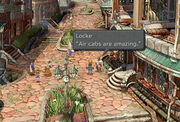
A man named Locke speaks with Zidane
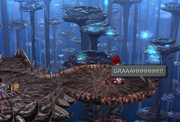
Kuja throws Garland off the ledge.
- Trance first appeared in Final Fantasy VI as Terra's skill after she unlocks her Esper powers. When in Trance, Terra would turn pink and be more powerful than normal, the same which happens in Final Fantasy IX. Trance was translated as "Morph" in the Final Fantasy VI English version.
- The Eidolon Madeen is misromanized; it was meant to invoke the name of Final Fantasy VI's Maduin (which, in the original Japanese versions of both games, was written as ディーン (Madiin)). Incidentally, the slightly-nonsensical name of its attack, "Terra Homing", was also intended to be "Terraforming". In juxtaposition, however, while FFVI's Maduin is male, FFIX's Madeen is female.
- In Lindblum, the characters may encounter an old man named Locke, possibly a reference to Locke Cole.
- The way Kuja throws Garland out of Pandemonium's platform is reminiscent of the way Kefka throws Emperor Gestahl out of the Floating Continent.
- Many character traits are shared between Beatrix and Celes Chere, one of the main protagonists of Final Fantasy VI. They were both incredibly powerful, loyal knights working for the enemy (Brahne and Gestahl, respectively), who begin to question their actions. They both come to their senses and begin to fight for the forces of good. They both fulfil the Japanese character archetype of the conflicted, long-haired, stalwart beauty, found commonly in today's popular Japanese anime and game culture.
- Mog is the name of Eiko's Moogle friend, as well as the Moogle that joins the party in Final Fantasy VI. In juxtaposition, however, the Mog of Final Fantasy IX is female.
- The floating eyeball monster, commonly known as Ahriman in the more recent games, was changed back to "Veteran", its Final Fantasy VI name.
- Beatrix and Steiner's sword ability, Shock, was the name of General Leo's commands in Final Fantasy VI.
- Flare Star, an attack used by Ozma and Trance Kuja, originated in Final Fantasy VI as one of the Atma Weapon's attacks.
- Many magic-based enemies in Final Fantasy VI could be defeated by draining their MP through Rasp or Osmose. The enemy Valia Pira can also be defeated in this manner through the use of Quina's Magic Hammer.
- The Desert Palace contains many works of fine art, including a trio of statues arranged in a triangular fashion. Two of these are decidedly demonic looking, replete with bat-like wings and tridents, and are referred to as the "Promise of the Evil God" and "Truth of the Devil". The white angelic statue in the middle is called the "Illusion of the Goddess". This is a direct allusion to the Warring Triad from Final Fantasy VI.
- The area around the Chocobo Forest is called the "King Ed Plains" in the menu, referencing Edgar Roni Figaro whom is the king of Figaro castle.
- Treno shares numerous similarities with Jidoor and Zozo, consisting of Jidoor's lower-class. The Treno wealthy live by the waterfront, while the poor live in the hills, paralleling Jidoor, which is by the ocean and Zozo, which is in the mountains. Both Treno and Jidoor were the only towns in the series to have an auction house. Treno is also home to many thieves, like Zozo, which is populated almost entirely of thieves.
- In the town of Alexandria there is a statue commemorating a General Madelene. In Final Fantasy VI Madeline was the name of Terra Branford's mother.
Final Fantasy VII
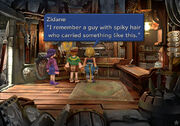
Zidane seeing the Buster Sword.
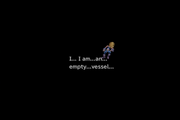
Zidane ponders over his existence.
- Likely the most straightforward allusion in the game, after the Prima Vista crashes into the Evil Forest, Tantalus' band begins playing "Rufus' Welcoming March" in an Active-Time Event, which plays in the background any time the player enters the city of Junon in Final Fantasy VII. To illuminate the band's allusion further, Baku even remarks "Hey, not bad!"
- The second encounter with Black Waltz No. 3 at the beginning of Disc 2 resembles a scene of the Nibelheim Incident told at Kalm by Cloud when the truck runs into a dragon: The clothing of the staff at the station and on the cable cars resembles that of Shinra soldiers and instead of a dragon, the party encounters the Black Waltz.
- Also, the song "Immoral Melody", one of Kuja's theme songs, bears a very striking similarity to the Shinra Company theme song.
- On the left side of the room inside the Inn located in Dali, a device will read the player's fortune and give the player his or her lucky color of the day. This is reminiscent of the first encounter Cait Sith has with the traveling party in Gold Saucer, where he keeps messing up the player's fortune.
- If the player examines a large, familiar looking sword in the Lindblum Weapons Shop, Zidane will say "I remember a guy with spiky hair who carried a sword like this..." a reference to Cloud Strife, the protagonist of Final Fantasy VII who carried a large sword named the Buster Sword.
- There is a little girl in Lindblum named Elena.
- During Disc 3, Alexandria is in ruins. In front of the relatively intact steeple on the edge of town, a woman bearing the title of "Flower Girl" says, "He's handsome, but he's not exactly Mr. Personality..." in reference to Weimar, Pluto Knight VII. If one substitutes Alexandria for the collapsed Sector 7, its steeple for the Sector 5 Church, the Flower Girl and Weimer for Aerith Gainsborough and Cloud Strife, the similarities suggest a connection that is quite intentional.
- Zidane and Cloud experience a very similar identity crisis: Zidane learns he is a Genome created for reaping the souls of Gaia, causing him to lose himself before his friends intervene and snap him out of it; in Final Fantasy VII Cloud is momentarily made to believe he is an artificially created clone and needs Tifa's help to come to his senses.
- During the play in Final Fantasy IX's ending, Marcus says, "No cloud, no squall shall hinder us!", referring to Cloud Strife of Final Fantasy VII and Squall Leonhart of Final Fantasy VIII.
- Again during the play Marcus is completely covered in a black robe and hooded so you cannot see his face. This looks very similar to what the Sephiroth Clones wear.
- Steiner and Beatrix both have an ability called Climhazzard, one of Cloud's second level Limit Breaks.
- Hades, a summon in Final Fantasy VII, was turned into an optional boss.
- Chocobo footprints on the world map are used to call chocobos in Final Fantasy VII, act a similar way in Final Fantasy IX.
- In the minigame "Mog's House" in Final Fantasy VII, the Moogle's favorite food was Kupo Nuts. In Final Fantasy IX, they appear as an item to feed a Moogle, and they remain a Moogle's favorite food.
- The ultimate Black Magic Doomsday alludes to Final Fantasy VII's Meteor Materia, said to be the Ultimate Black Magic as well.
- The monster Stilva shares the same name and appearance as Stilva found in Gaea's Cliff.
- Both the Gaia of Final Fantasy IX and Final Fantasy VII display similar foundational life cycle structure and, thus, primary character conflicts and motives:
- In Final Fantasy VII, all life consists of Mako; when a lifeform dies, its mako energy returns to the planet's Lifestream where it is recycled and born again elsewhere; the byproduct of concentrated mako released on the planet's surface is Materia. As a powerful energy source, Mako is used to power the planet's urban areas, which Jenova and Sephiroth adversely used to summon powerful monsters to inflict harm on the masses. Exposure to excess mako can lead to poisoning. Sephiroth attempts to harness the power of the Black Materia's Meteor spell to exterminate all life on the planet. His motive stems from Jenova, an extraterrestrial bent on eradicating the planet of its "impure" current inhabitants so that it may start its new perfect race in their wake. Sephiroth was created from Jenova's cells, and for some time believes it to be his mother. Because of their similar origin in this respect, Sephiroth's remnants refer to Cloud as "brother".
- In Final Fantasy IX, every life possesses a soul; when a lifeform dies, its soul attempts to return to Gaia's Crystal but is intercepted and sorted by the Iifa Tree, where its energy is permeated through the tree's roots; the byproduct of concentrated release of the souls on the planet's surface is Mist. As a powerful energy source, Mist is used to power the planet's booming industrial age, which Kuja adversely used to summon powerful monsters to inflict harm on the masses. High concentrations of Mist often bring about monsters. Kuja attempts to harness the power of the Iifa Tree, diverting the Mist to the village of Dali, creating a soulless, golem Black Mage army so as to exterminate all life on the planet. His motive stems from commands issued by Garland, an extraterrestrial bent on eradicating the planet of its "impure" current inhabitants so that he may possess his perfectly engineered Genome race with slumbering souls of his Terran people. Kuja is such a genome, and therefore views Garland as a father of sorts. Because of their identical origin, Zidane addresses Kuja and Mikoto as his brother and sister.
Final Fantasy VIII
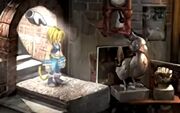
The "Chicobo" Sculpture in the Artist's Studio in Lindblum.
- Squall is mentioned in the game's ending. (See above section.)
- Freya's White Draw skill is similar in use and effect to the Draw command in Final Fantasy VIII.
- Amarant's No Mercy ability is a reference to Seifer's Limit Break attack of the same name. Both attacks involve a large ball of energy to be formed by the user.
- The roles of Queen Brahne and Sorceress Edea are similar in that they are both regarded as the villain for the early portion of the story until both are revealed to be controlled by the true villain. Both characters also play the role of a maternal figure for a member/members of the party, though they are not related by blood (Brahne for Garnet; Edea for Squall and co.). Also of note: the GF Alexander can be drawn from Edea during the second fight with her while the Eidolon Alexander is the protector of the kingdom Alexandria of which Brahne is queen.
- A fine artist in Lindblum's Theater District can be seen painting in his art studio throughout various parts of the game (where actor Lowell Bridges takes refuge from rabid fangirls, and later where Zidane finds the Strange Potion Key Item). Amongst his belongings standing atop a high shelf is a sculpture of a Chocobo. It takes a keen eye, however, to notice that this sculpture bears no resemblance whatsoever to the Chocobo models used in Final Fantasy IX; it is in actuality the Chicobo model used in Final Fantasy VIII's Chocobo Hide & Seek minigame.
- Cid Fabool VIII, Regent of Lindblum, father and predecessor to Cid IX, is credited with a number of pivotal technological accomplishments, transforming his Regency into an industrial powerhouse on the forefront of scientific advancement. He also leads Lindblum through a bloody war with Alexandria. A statue in his honor was erected in Lindblum's Industrial District, but it is destroyed later in the game. Cid VIII in some respects parallels Laguna Loire: he is leader of the most technologically advanced nation in the game, Esthar; he obtained this position by leading the assault against Sorceress Adel in the Sorceress War; he is succeeded by another powerful military leader, his son Squall; and a statue of him was erected in the Shumi Village to commemorate his compassion and dedication as a leader.
- Amongst his other accomplishments, Cid VIII is credited with constructing the Burkmea cable cars which run on either side of South Gate. The cars were built to commemorate 20 years of peace between the nations of Alexandria and Lindblum across the Aerbs Mountains, a natural barrier between the regency and kingdom. After the Mist disappears, they become inoperable. This references the Horizon Bridge commissioned and constructed by Esthar to span the vast natural sea between the Galbadia and Esthar Continents. It was completed "around the time the war broke out" to join Deling City to Esthar peacefully via railway. When the Sorceress War occurred, the Horizon Bridge was left in disarray, and its builders (pacifist defectors from Esthar now inhabiting Fisherman's Horizon) ceased its maintenance and operation.
- Squall crosses the length of the bridge on foot with an unconscious Rinoa on his back, as it is the only known means of crossing the border into Esthar; unorthodox border crossing is a recurring theme in Final Fantasy IX, the first time coincidentally being through South Gate.
- The Horizon Bridge itself is an allusion to the Big Bridge in Final Fantasy V.
- In the Rare Phantom's small room in Memoria, the game's final dungeon, there is a large malfunctioning clock face with nonsensical glyphs and six jittery hands. This may reference the giant broken clock in Ultimecia Castle, Final Fantasy VIII's final dungeon which itself alludes to the number eight.
- The main melody of the theme "Hunters' Chance" strongly resembles the main melody of the theme "The Landing" from Final Fantasy VIII.
- The theme that plays while fighting Trance Kuja, "Dark Messenger", shares its name with Diablos' GF ability.
Final Fantasy Tactics
- In Final Fantasy IX Garnet was an orphan who was adopted and raised as royalty due to the real princess having died young. The same fate befalls Princess Ovelia in Final Fantasy Tactics. In the same spirit, the game's epilogue shows Eiko forcing her adoption on Regent Cid and Hilda, though they have no prior known children.
- A large number of equipment names and abilities are taken straight from Final Fantasy Tactics.
- Many of Steiner's sword skills are named from Final Fantasy Tactics.
- Before Final Fantasy IX, perfumes or fragrants are only equippable in Final Fantasy Tactics. They can only be equipped by female characters as well. The rouge itself was however retroactively introduced into Final Fantasy Tactics: The War of the Lions.
- In Disc 4, one of the people in Treno is named Worker #9, a reference to Worker-7-New and Worker 8.
- The game-long side quest involving the Stellazio coins uses the names of the twelve signs of the zodiac; though a common reference in the role playing genre, this may be a nod toward story of the Snake Zodiac in Final Fantasy Tactics.
- Freya's ability, "Reis's Wind", is named after Reis Duelar of Final Fantasy Tactics.
- Another of Freya's abilities, "Cherry Blossom", was Cloud Strife's 8th Limit in Final Fantasy Tactics.
Allusions to the Number Nine
- There are exactly nine active members of the Knights of Pluto, not to mention that at the time of the game's release Pluto was considered the ninth planet of the Earth's Solar System.
- Likewise, prior to the game's start and excluding band members, there are nine active players in the Tantalus Theater Troupe's gang of thieves: Baku, Zidane, Blank, Marcus, Cinna, Ruby, and the three Nero Brothers.
- There are numerous boats, airships, and war machines in the game, but only nine of these vessels carry names: the Prima Vista, the Cargo Ship, the Blue Narciss, the Viltgance, the Hilda Garde Marks I, II, and III, the Red Rose, and the Invincible.
- Regent Cid Fabool IX is quite obviously the ninth Cid in Lindblum's royal lineage.
- His predecessor and father, Cid VIII, developed the first Mist-powered airships in 1762, led the Lindblum armada in 1771, and died in 1780; each event has a span of nine years between them.
- The Prima Vista theater ship weighs exactly 8,235 tons and has a guest capacity of 288 passengers. Both figures are multiples of 9.
- In the song "Ambush Attack", Uematsu pulls off an obscure 9/4 time signature in the piece's opening measures before switching to 4/4.
- If one counts Alexander, Garnet has access to exactly nine Eidolon summons.
- While Eiko only have access to 4 Eidolon, she has exactly 9 types of Eidolon attack (Diamond light, Phoenix's auto summon, etc)
- An aforementioned Final Fantasy Tactics allusion references Worker #9.
- One of Zidane's Dyne abilities is called Solution 9.
- Altogether, there are nine friendly monsters in the game-long side quest to limit Ozma's powers.
- Vivi's given age is 9, though other references have him "born" in 1799, the year before the game's events.
- The game plays host to a total of nine diverse races with basic levels of intelligence:
- The Humans of Gaia, including Steiner, Beatrix, Amarant, Lani, and Cid.
- The Summoner Tribe of Madain Sari, survived only by Garnet and Eiko.
- The Qu Clan, of which there are only three known members.
- The Dwarfs of Conde Petie.
- The Moogles, including Kupo, Stiltzkin, and Artemicion.
- The Humans of Terra, of which only Garland is known, as the remaining souls lie in limbo.
- The artificial Genomes Garland creates as hosts for the Terran souls, including Kuja, Zidane, and Mikoto.
- The artificial Black Mage golems Kuja creates, including Vivi and the Black Waltzes.
- A miscellaneous collective of anthropomorphic animal-like human creatures including dogs, pigs, hippos, walruses, lions, and most notably the rodent citizens of Burmecia and Cleyra, including Freya, Fratley, and Puck.
- Before Zidane and Garnet go through the marriage ritual in Conde Petie to pass to the Iifa Tree, 99 other couples had gone through the ritual.
- Every single magical spell and skill in the game falls under one of 9 major categories: Black Magic, White Magic, Blue Magic, Summon/Eidolon Magic, Flair/Elan Skill, Dragon Skill, Thief Skill, Seiken/Sword Art, or Dyne skill.
- Among these spells and skills, the digit 9 never occurs in any place value of any MP cost.
Other Square projects
Vagrant Story
- The barkeep, and later mini-theater owner, in Alexandria shares the same name and hair style of Ashley Riot, Vagrant Story's protagonist.
Chrono Cross
- Zidane's "Thief Swords" greatly resemble Serge's double-bladed swords.
Parasite Eve
- Final Fantasy IX also has a reference to another Square game, Parasite Eve, with the two owners of the synthesis shop in Lindblum, Torres and Wayne. Also, in Parasite Eve Torres dies, but in Final Fantasy IX, Torres is merely badly injured after Alexandria attacks. The two of them also have a skirmish which is practically the same as the "Safety vs. Power" lecture overheard when first entering the NYPD weapons room.
Super Mario RPG: Legend Of The Seven Stars
- The Myconid returns from Super Mario RPG: Legend of the Seven Stars.
Secret of Mana
- The 14th track on the soundtrack, "Thy Warmth", shares uncanny similarity with the song from Secret of Mana, "Spirit of the Night".
From mythology, television shows, video games, film, and other media.
Other Games
- The fountain inside Lindblum Castle, upon interacting with it, mentions, "...Looks like there's no place to put the medal here." Since there are no puzzles, plot points, or anything else in the game related to this fountain, it can be assumed this is a direct reference to a similar event that takes place in Resident Evil 2.
- On the floor of the Star Display room in Oeilvert is the symbol of the Triforce (three isosceles triangles joined together at the corners to make one, larger triangle with its center missing). Though this may be the symbolic primary interest of the cast of the Legend of Zelda series, the "Triforce" shape is a common pattern that has been used in Japanese embroidery, clothing design, and architecture for centuries. It is therefore doubtful the "Triforce" in Oeilvert -- or the actual Gulug Stone Key Item upon which it obviously references in a cutscene seconds later -- has much if anything to do with the Legend of Zelda series.
Movies & Television
- In Lindblum, a man near the air cab station will say "Dammit Jim, I'm a doctor, not a miracle worker!", a quote from Star Trek.
- Before fighting Black Waltz #2 he says the phrase "Resistance is futile", a reference to the Borg.
- Necron's quote "Fear leads to anger. Anger leads to hate. Hate leads to suffering", originally belonged to Yoda in Star Wars: Episode I: The Phantom Menace.
- The fighting sequence between Alexander and Bahamut bears a resemblance to a scene from the anime Macross.
- After fighting Steiner at the beginning of the game, he says "Bah! Only a flesh wound," a reference to a famous line of Monty Python and the Holy Grail's black knight character.
- Similarly, one of the few things Zorn and Thorn say in unison is "Run away!!"
- In disc 3, Ruby refers to Blank and Marcus as "those good ol' boys". Considering Ruby's Southern belle persona, this is most likely a reference to The Dukes of Hazzard.
- After recieving a Kupo Nut, one moogle remarks that he's "Kupo for Kupo Nuts" a parody of the Cocoa Puffs commercial.
- During the Festival of the Hunt, a man being chased by a Mu screams "Great Scott!", a reference to the Back to the Future trilogy's Doc Brown character, who shouts it multiple times throughout the films.
Literature
- There are numerous Shakespearean allusions throughout, including the name of the Prince of Burmecia and the play I Want To Be Your Canary. The author of these plays, Lord Avon, is a direct reference to Shakespeare himself who was referred to as the "Bard of Avon".
- 2 enemies fought in the game: Jabberwock and Bandersnatch are two creatures from Lewis Carroll's famous poem "Jabberwocky". These names were also used for two bosses in Final Fantasy XIII.
- The idea that the monsters of the world all originate from Mist is similar to the premise of the Stephen King novel The Mist.
Cultural
- As mentioned earlier, the game details a strained romance between Part Time Worker Mary, owner of the Vega Shop in northern station of South Gate, and Jobless Jeff, operator of the Altair Shop in the southern station, which mirrors the real-life Tanabata legend.
- The ceremony for the magical sandstorm that protects Cleyra is a homage to Riverdance.
- Madain Sari is named after a pre-Islamic archaeological site called Mada'in Saleh. In the Qur'an, the people of Mada'in Saleh, the tribe of Thamud, or the Thamudis, were a tribe that fell to the worshipping of idols. The Thamudis were called by the Prophet Saleh, who came under the command of Allah, to repent for what they had done. They did not believe him and commanded him to summon a pregnant she-camel from the back of a mountain to prove himself. And so, Allah sent the pregnant she-camel from the back of the mountain to prove that the Prophet Saleh spoke the truth. The non-believers killed the pregnant she-camel, while some repented. The calf ran back to the mountain, screaming. After three days, Allah sent earthquakes and lightning blasts to kill all the Thamudis.
The links are drawn from the following:
- The summoning of the pregnant she-camel to the fact that Madain Sari revolves around summoning.
- The worshipping of idols, which are the Eidolons.
- The destruction of Mada'in Saleh through natural disasters, although through means besides natural occurence.
Others
- When Steiner witnesses the barrels with the Alexandria crest being loaded in Dali village, he pokes one barrel with his sword, and Zidane, a thief who lives on an airship, pops out - a reference to the popular Kurohige pirate-in-a-barrel game.
Template:FFIX
